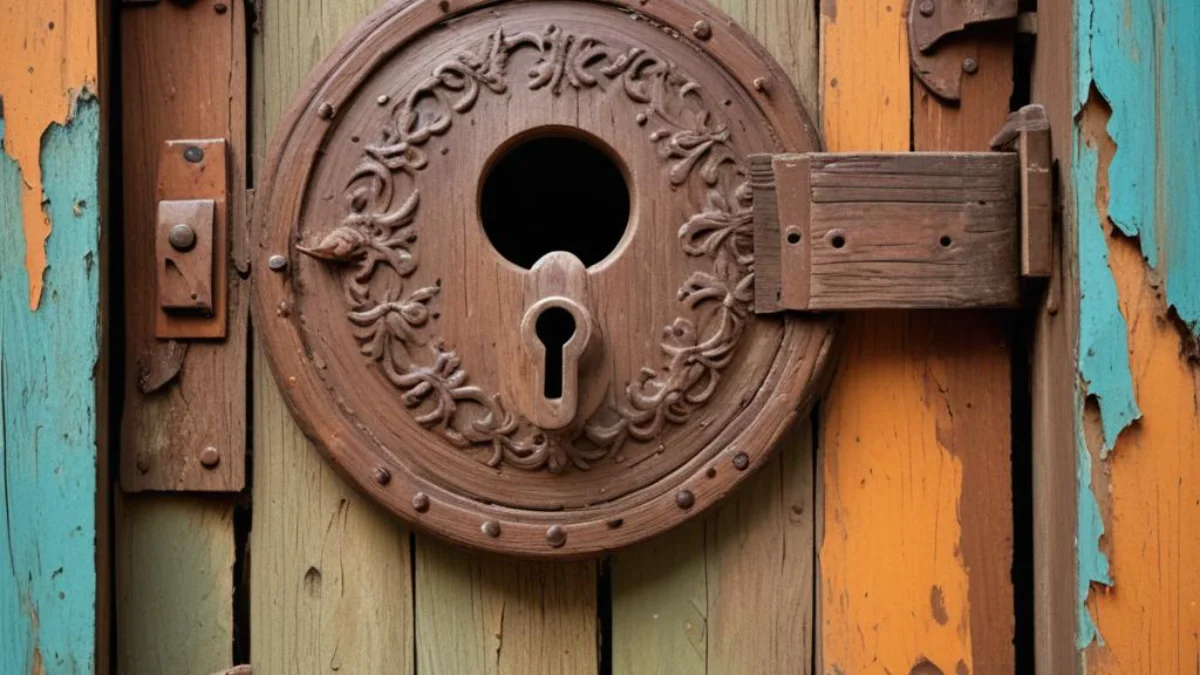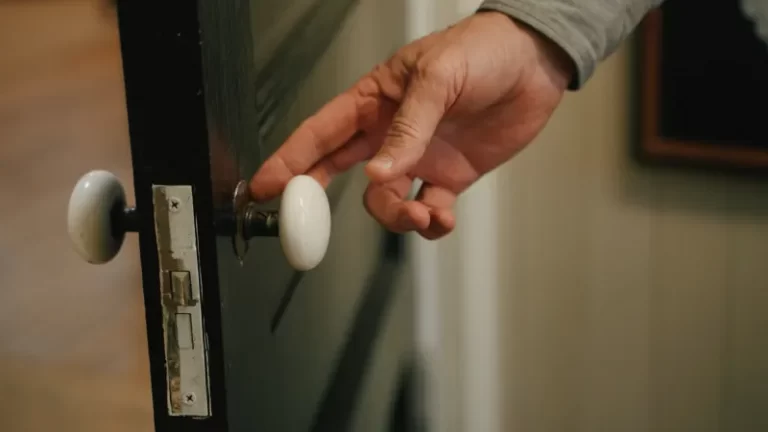How to Fix a Door Lock Hole With Deteriorated Wood Now
A loose, wobbly doorknob isn’t just an annoyance; it’s a serious security flaw. When the wood around your door lock hole becomes deteriorated, stripped, or rotted, it compromises the single most important security feature of your home.
This common problem can happen for many reasons. Constant use, changes in humidity, a poorly installed lock, or an attempted break-in can all lead to splintered, weakened wood that can no longer hold a lock securely in place.
You'll Learn About
Why You Can’t Ignore a Damaged Door Lock Hole
Putting off this repair is a gamble you shouldn’t take. The consequences of a failing door lock extend far beyond simple inconvenience, impacting your home’s safety, energy efficiency, and your wallet.
The Obvious Security Risks
A lockset is only as strong as the door and frame holding it. If the wood is weak, a simple kick or shove could be enough for an intruder to force the door open, bypassing the lock entirely.
This turns your sturdy deadbolt into a false sense of security. The structural integrity of the door itself is the foundation of its protective power, and deteriorated wood is a critical failure of that foundation.
Energy Loss and Increased Bills
A loose-fitting lock and strike plate create gaps around your door. These gaps allow conditioned air to leak out and outside air to seep in, leading to drafts and temperature fluctuations.
Your heating and cooling systems must work harder to maintain a comfortable temperature. This constant extra effort translates directly into higher energy bills month after month.
Further Damage and Costlier Repairs
Ignoring soft or splintered wood is an invitation for more extensive problems. Moisture can penetrate the weakened area, leading to progressive wood rot that can spread to the rest of the door and even the door frame.
What starts as a simple fix for a stripped screw hole can escalate into a full door replacement. Addressing the issue promptly saves you from much more expensive and labor-intensive repairs down the line.
First Steps: How to Assess the Damage
Before you can choose the right repair method, you need to accurately gauge the extent of the problem. Remove the lockset and faceplate completely to get a clear view of the wood inside and around the bore hole (the large hole for the lock body) and the latch hole.
Minor Wear and Stripped Screw Holes
This is the most common issue. The screw holes for the faceplate or strike plate have become enlarged, and the screws just spin without tightening. The wood around the main hole is still solid.
You may also see some minor chipping or cosmetic wear. This level of damage is typically easy to fix with simple materials and doesn’t compromise the door’s core strength significantly.
Moderate Splintering and Cracks
Here, you’ll see visible cracks or splintering radiating from the lock holes. The wood feels a bit soft or “punky” when you probe it with a screwdriver, but it hasn’t completely disintegrated.
This level of damage requires a more robust solution than simple wood filler. The goal is to not only fill the gaps but also to reinforce the weakened wood fibers to restore structural integrity.
Severe Rot and Wood Decay
If the wood is dark, crumbles easily, or feels damp and spongy, you’re dealing with wood rot. There might be large missing chunks of wood, and the hole may be significantly misshapen.
This is a serious structural problem that requires an aggressive repair approach. Simply filling this void will not be sufficient; you must first remove the rotted material and stabilize the surrounding wood.
Choosing Your Repair Method: A Comparison
With a clear understanding of the damage, you can select the best repair strategy. Each method has its pros and cons depending on the severity of the deterioration and the durability you require.
| Repair Method | Best For | Durability | Difficulty |
|---|---|---|---|
| Wood Filler / Putty | Minor cosmetic issues, small chips | Low | Easy |
| Hardwood Dowels / Plugs | Stripped screw holes | High | Easy |
| Two-Part Epoxy Filler | Moderate to severe damage, rotted wood | Very High | Medium |
| Door Reinforcement Plate | Cracked or split doors, added security | Very High | Medium |
The Quick Fix: Temporarily Securing Your Door
If you discover the damage late at night or don’t have time for a full repair, you need a temporary solution to secure your home. While not a permanent fix, understanding some basic measures can provide peace of mind.
In a true emergency, knowing different ways to secure a door is crucial. While we focus on repair, understanding how to temporarily secure a compromised entry point is a valuable skill. In some situations, understanding how to jam a lock can provide a last-resort barrier until a proper fix can be implemented.
Step-by-Step Guide: Repairing Minor Damage with Wood Filler & Dowels
For stripped screw holes and minor cosmetic flaws, this method is fast, effective, and requires minimal tools. It restores the wood’s ability to hold screws tightly.
Tools and Materials You’ll Need
Gather your supplies before you begin. You will need a drill, wood glue, hardwood dowels or toothpicks, a chisel, sandpaper, and stainable wood filler for any cosmetic touch-ups.
Step 1: Clean and Prepare the Area
Use a small pick or screwdriver to clean out any loose wood chips or debris from the stripped screw holes. A clean surface is essential for a strong bond.
Step 2: Fixing Stripped Screw Holes
For a rock-solid fix, use hardwood. Dip several toothpicks or a properly sized hardwood dowel in wood glue. Insert them into the stripped hole until it is completely filled.
Let the glue dry completely, then use a sharp chisel or utility knife to cut the dowels flush with the door’s surface. This new wood provides a solid base for the screw to bite into.
Step 3: Applying Wood Filler for Cosmetic Issues
If there are small chips or gouges around the lock, apply a quality stainable wood filler with a putty knife. Overfill the area slightly to account for sanding.
Step 4: Sanding, Drilling, and Finishing
Once the filler and glue are fully cured, sand the repaired areas smooth, starting with medium-grit sandpaper and moving to a fine-grit. Drill a new, properly sized pilot hole in the center of your dowel repair. Reinstall the hardware and touch up with paint or stain.
The Ultimate Fix: Using Epoxy for a Rock-Solid, Permanent Repair
When you’re facing moderate to severe damage, splintering, or wood rot, a two-part epoxy filler is the superior solution. It creates a repair that is often stronger than the original wood itself.
Why Epoxy is the Professional’s Choice
Unlike standard wood filler, which can shrink and crack, epoxy creates a chemical bond with the wood fibers. It fills voids completely and cures into a hard, waterproof, and drillable material that won’t fail under pressure.
This method rebuilds the damaged section of the door, restoring its structural integrity for the long term. It is the go-to choice for preserving older or custom doors where replacement would be difficult or expensive.

Essential Tools for Epoxy Repair
You will need a two-part wood epoxy filler, a liquid wood hardener (consolidant), a sharp utility knife or chisel, a drill, putty knives, and painter’s tape to act as a dam or mold.
Step 1: Removing Rotted Wood
You must remove all the soft, rotted wood. Use a chisel, screwdriver, or a rotary tool to scrape and dig out all the decayed material until you reach solid wood.
This step is critical. Applying epoxy over rotten wood will result in a failed repair. The area must be clean, dry, and free of any loose fibers for the epoxy to bond correctly.
Step 2: Applying Wood Hardener
Once the rotted wood is removed, liberally apply a liquid wood hardener to the exposed, solid wood. This chemical soaks into the wood fibers and strengthens them, creating a solid foundation for the epoxy filler.
Allow the hardener to cure completely according to the manufacturer’s instructions. The wood should feel hard and solid to the touch before you proceed.
Step 3: Mixing and Applying the Epoxy Filler
Mix the two parts of the epoxy filler according to the directions. Work quickly, as you only have a limited working time before it begins to harden. Use painter’s tape on the opposite side of the hole to prevent the epoxy from pushing through.
Press the epoxy firmly into the cavity, ensuring you eliminate any air pockets. Overfill the area slightly, as you will sand it down later. Use a putty knife to shape the repair as close to the final form as possible.
Step 4: Shaping, Curing, and Re-drilling
Once the epoxy has fully cured (this can take several hours), it will be extremely hard. You can now sand, file, or shape it just like wood. Sand it flush with the door’s surface.
Now you need to re-drill the necessary holes. Achieving a perfectly straight pilot hole is crucial for the lock to function smoothly; the principles are similar to when you need to drill a hole from inside to outside for other complex projects. Use the lock’s template to mark your hole centers accurately before drilling.
Beyond the Hole: Installing a Door Lock Reinforcement Plate
For maximum security, especially on a door that has been previously damaged or feels flimsy, consider installing a metal door reinforcement plate. These plates wrap around the edge of the door, strengthening the area around the lock and deadbolt.
They not only cover up old damage for a clean look but also distribute the force of a potential kick-in over a much larger area of the door. This simple addition can dramatically increase the security of your repaired door.
Pro Tips for a Flawless and Lasting Repair
A good repair is one that lasts. Prevent future damage by using the correct tools and avoiding unnecessary force during installation or everyday use. Sometimes, the best approach is a no-impact one, a concept that applies whether you’re fixing a door or learning how to install an AC without drilling.
Always drill pilot holes for your screws. This prevents the wood from splitting and ensures the screws go in straight and tight. When reinstalling hardware, do not over-tighten the screws, as this can crush the wood fibers and lead to premature failure.
When to Call a Professional: Know Your Limits
While these DIY repairs are effective for most situations, there are times when calling a professional locksmith or carpenter is the best course of action. If the door is split entirely, the damage extends deep into the core, or the door frame itself is also rotted, a professional assessment is needed.
If you don’t feel confident in your ability to perform the repair correctly, it’s better to hire an expert. A faulty lock repair can leave your home vulnerable, so it’s a job that needs to be done right.
Conclusion: A Secure Door is a Secure Home
Fixing a deteriorated door lock hole is a project well within the reach of most homeowners. By correctly assessing the damage and choosing the right method, from simple dowels for stripped screws to a robust epoxy repair for rotted wood, you can restore your door’s integrity and security.
Don’t let a wobbly doorknob compromise your peace of mind. Taking the time to address the issue promptly and properly ensures your door remains a strong, reliable barrier protecting your home and family.


